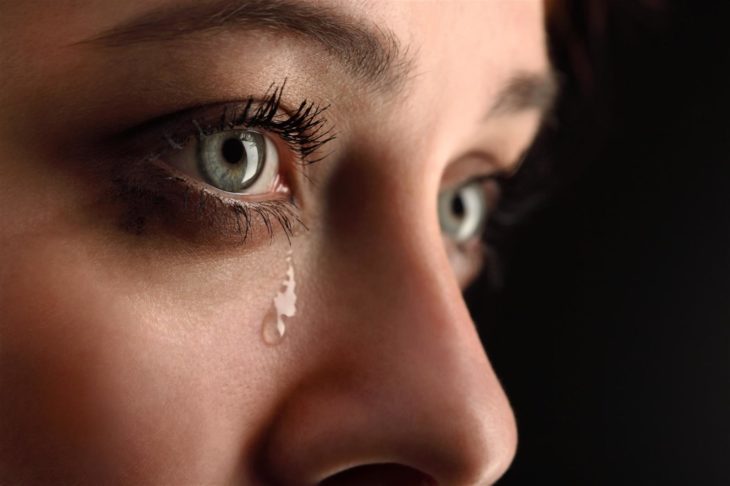Do you remember laying flat on your bed, eyes gushing like Old Faithful, unsightly snot dripping down way too close to your open mouth? This is you after your dog died. This is you after a break up. This is you after failing to assemble an Ikea chair.
This image comes frighteningly close to what I was doing this week. My best friend and roommate moved to another state and an onslaught of huge life changes came my way. While making like weeping roadkill, Kate Bush’s song, “Suspended in Gaffa” came through my head. I don’t know why I’m crying, Kate croons.
“Wait, I don’t know why I’m crying,” I thought to myself.
So, I did my homework.
Charles Darwin’s findings show us that tears are a survival mechanism to maintain a healthy eye, free of dust and other debris. Each time we blink, tear ducts located in the upper eyelid lubricate the entire eye with a salty liquid to protect them. There are three types of tears.
These first tears are called basal tears, in charge of moisture and upkeep.

Source: mieye
The second type of tear, reflex tears, are sort of like those ominous eyewash showers in high school science labs. They react to foreign materials and other irritations coming in contact with the eye, such as pepper sprays or the gas released from the cutting of an onion.
The third type of tear, emotional or psychic tears, are released when humans come under severe stress, physical pain, anguish, sadness, trauma, and large shifts or swells in feeling—both positive and negative.
There is a direct neuronal connection between the brain and the tear ducts. Along with emotional tears, this crying can involve other physical symptoms like the feeling of a lump in our throat, a trigger from our sympathetic nervous system known as the globus sensation, a runny nose, an increase in heart rate, and a shift in breathing. While Darwin insisted he witnessed elephants and chimpanzees crying these emotional tears, and we’ve heard songs about the crocodile variety, modern science still says humans are the only animal on the planet proven to display grief and distress through their eyes.
Our emotional states aren’t the only thing that makes this third type of tears something special. Their chemical makeup is different. Emotional tears have more manganese, associated with temperament. They also contain prolactin, the relaxing hormone in charge of milk production and the “okay, I’m going to nap now” feeling of satiation experienced after sex. Thus, we feel an immense release of tension and a feeling of coming down off an emotional peak when we rid ourselves of this manganese and prolactin pipe clog.

Source: washingtonpost
While writhing on the floor covered in your own sweat and listening to the same Otis Redding song on repeat may seem as evolved as australopithecus, the fact is, crying is a very evolved behavior. Tears aren’t just physiologically cathartic, anthropologists and psychologists have studied how crying is our most basic and probably our most essential form of human communication. When we’re first born, the only way we can convey things to our caretakers is by crying. A colicky baby may be an insanely frustrating experience for new parents, but these first tears are a tiny human’s mode of survival. Whatever these tears mean—hold me, feed me, I pooped my pants—they forge bonds between mother and child and incite sympathy from the start of their relationship.
As we become older, we sympathize with criers and have the urge to care for them because we are reminded of babies. Crying elicits compassion and mercy because it is a physical representation of submission, vulnerability, and need. Tears reduce vision, leaving the crier, in a biological sense, completely disarmed. Witnesses to the tears, friend or foe, will then feel a pull of attachment or empathy towards this display of helplessness. Tissue-giving, violin-playing, and hugging may ensue.
Blubbering about can also be a sort of team building exercise for groups of friends, families, and other communities. Through the established societal practice of crying, for both sad and happy reasons, at events like funerals and weddings, we are creating commonalities and group identities. Anthropologically speaking, a group may feel unified once each member has mutually engaged in these acceptable instances of crying, cementing bonds and loyalties.
Blubbering about can also be a sort of team building exercise for groups of friends, families, and other communities. Through the established societal practice of crying, for both sad and happy reasons, at events like funerals and weddings, we are creating commonalities and group identities. Anthropologically speaking, a group may feel unified once each member has mutually engaged in these acceptable instances of crying, cementing bonds and loyalties.

Source: scmp
The authenticity of your tears is also a factor in establishing real bonds. If you’re faking it, you probably won’t win anybody’s “awws.” Another demarcated sphere where crying won’t get you too far: the workplace. Work is an environment where we are supposed to become depersonalized, making our inner stories less significant in order to promote efficiency and productivity. So, wailing in front of your boss while she’s trying to eat lunch? It doesn’t bode well for maintaining a steely facade and is rarely seen as culturally acceptable. And sadly, men are sometimes seen as weaker rather than more approachable when they weep. Whether its due to a lack of a hormone-altering menstrual cycle or because of cultural boys-don’t-cry ideology, studies report that men cry about once a month compared to the five times a month women do.
Crying is an awe-inspiring phenomenon, whether we do it weekly or almost never. The fact that any crying human can be understood in any country, in any language, as someone in an overwhelmed emotional state is truly a-maz-ing. It works, too. I know I feel significantly more relieved after a good eight-minute bawl. So, I say, embrace the snot bubbles. Lacrimate to your heart’s content. And next time you find yourself sobbing on a crowded subway platform, and some stranger asks you what is wrong, you can assure them that you’re just practicing non-verbal, cross-cultural communication and looking to forge new bonds by displaying vulnerability. You might get a funky look, but hey, remember, you’re no crocodile: you’re only human.
Original by:
